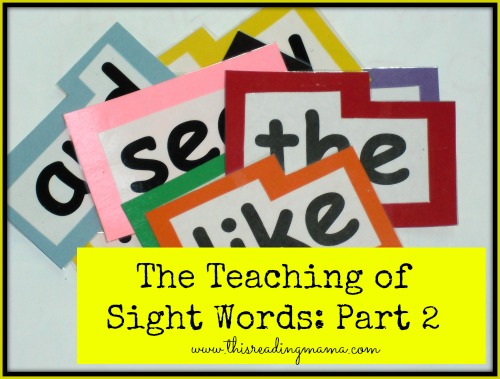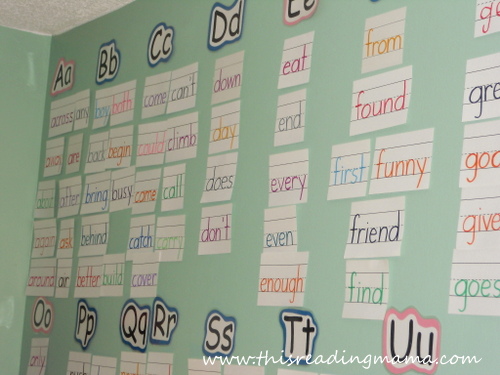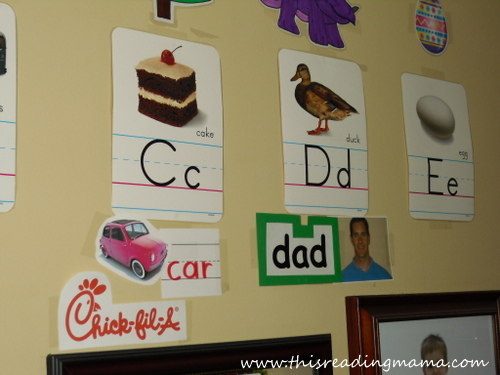 Last week, I talked a little about how what sight words are and how I pick sight words for my kids to learn. If you missed that post, please click here or on the picture above to view it. Today, I’d like a address what to do with the sight words once you know which words and books you want to use.
Last week, I talked a little about how what sight words are and how I pick sight words for my kids to learn. If you missed that post, please click here or on the picture above to view it. Today, I’d like a address what to do with the sight words once you know which words and books you want to use.
Sight Words in Reading
Before I mention anything else, I want to stress that I always link the individual sight words {out of context} to a book or real reading {in context}. Like I said last week, one way I do this is to pick my sight words directly from the books my child is reading for the week. Another way we do this is to look for those words as I read aloud. Just a simple comment like, “Hey, you know that word!” encourages young readers to see that words serve a purpose. Sometimes we highlight, underline, or circle the words. If we don’t own the book, sometimes I’ll make a copy of the book just for our purposes, slip the page into a plastic sleeve protector and then use dry erase marker. If one particular sight word is mentioned over and over, I may have my child keep tally marks as he reads along. The great thing about sight words from the Dolch and Fry list is that they are so frequent, you are bound to run into them…and often.
Play Games and Have Fun!
Because kids love to play games, sight words games are fun with kids. The good news is that games don’t have to be complicated. They can be as simple as Roll and Write a Sight Word or any of the sight word games we used last summer. It is good to not only include the current sight words in the game, but review old ones as well to keep them fresh in the mind. Two other sites I like to find sight word games are Playdough to Plato and Mom 2 Posh Lil Divas. You can also find more games on my Sight Word Pinterest board.
Keep a Word Wall
Ever noticed that your child can read and spell a sight word the week you’re studying it, but then it seems to completely disappear from the brain after that? Enter the word wall. Word walls are a place to record all of the words you and your child have studied. This keeps me from being my child’s only resource for reading the spelling. He refers to it as often as he needs.
I have two walls in my schoolroom designated for word walls:
One for ALuv {end of 1st grade}- I used sentence strips for his words. Notice I wrote them on different colors. This is a great tip for young readers/spellers so they don’t confuse the words as easily. For example, if he wants to know how to spell then I can say, “Well, it starts with a th and is light blue.”
and one for NJoy {4 years old…these come from my Reading the Alphabet curriculum}
Word walls come in all sizes and shapes as Debbie shows in her round-up of word walls. Kristen demonstrates how you can make a sight word chart to display in the kitchen and I love how Playdough to Plato shows how to make a word wall on a single sheet of paper. Super simple.
Another place that I record ALuv’s words are in his word wall folder. Just take a simple manila folder and divide it up by letter on the front, middle, and back. Once the week is over, write the sight words studied in the folder under the appropriate letter. I love our folder because it is mobile. If ALuv needs to finish up an assignment in the kitchen or he wants to write outside, this can travel with him.
And word walls don’t always have to be for sight words on a pre-made list. Math, literary, or science terms can be used instead. In the playroom, I have another word wall. Here we keep our environmental print and any other words that are important to my younger children {note: they aren’t always official “sight words”}.
Sight Words in Writing
ALuv currently has 5 words a week. During the week, the sight words are displayed on our “New Words” board like I showed in Part 1. Once the week is over, the words are placed on the word wall and in his manila folder. When he is writing, I expect those sight words to be spelled correctly. I don’t care if he has to look at the word wall to remember how to spell them, but now there is no excuse for misspelled words. {By the way, if a word is NOT on his word wall yet, I don’t always expect it to be spelled correctly. One exception to this rule is if we’ve studied the word pattern in word study, I expect it to be spelled correctly. He also has a word study notebook to record all of the spelling patterns he’s learned.}
How do you keep sight words fresh in your child’s mind after they have been introduced? Please feel free to leave a comment or a comment/URL below if you have more ideas!
~Becky




I love word walls, but our limited space we do word folders more than anything. I print as small as I can and go that route! Sight words are always fun!
These are wonderful ideas. I have been questioning the order in which to introduce sight words, and how best to review them. We are now up to 15 sight words, -at word family, and color words; I needed some help to organize these and help reviewing them without just reading word from a card. My background in education didn’t prepare me for this (secondary ELA degree); I’m learning as we go. Your blog and additional resources have been a huge help to me. Thank you!! My daughter asked to learn to read earlier in the year, and I very incorrectly assumed she was too young. I found some online resources that gave me the confidence to begin teaching my daughter to read, spell, and write. I am finding out she Is more than ready and capable. Thank you for sharing your tips and ideas. They have certainly helped. 🙂
I love these ideas. I’m planning to make the file folder example for my struggling reader. Thanks for sharing!
You’ve written a great blog post. I learned a lot from this article. Lots of good and beautiful articles. I learned from this post what I didn’t know about the “The Teaching of Sight Words: Part 2” before. It is very helpful for everyone. Every tip is very effective for the teacher. Every idea is awesome and new to me. I will be following your ideas.
Thank you for sharing a great post to help the teachers.